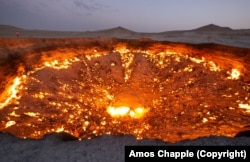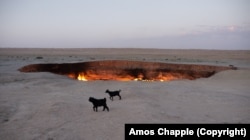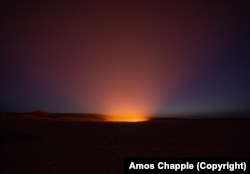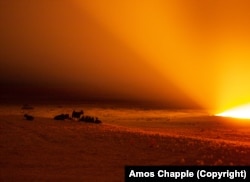In the wake of Turkmen President Gurbanguly Berdymukhammedov's order to extinguish the flaming Darvaza gas crater, photographer Amos Chapple recalls visiting the site before it became one of Turkmenistan's most famous tourist destinations.
I assumed I was looking at a volcano.
In the summer of 2007 I was on a late-night flight from Istanbul to Tashkent. As we overflew Turkmenistan's Karakum Desert I was staring out of the window, peering down at the occasional brightly lit Turkmen towns, fascinating for their waffle-like street patterns, when our plane passed a massive, fiery hole in the desert.
I was transfixed for several minutes as we tracked past the flaming crater. When I finally poked my head above my seat to ask someone the obvious question -- "What the hell was that?" -- there was no one awake in the mostly empty plane to ask.
Details of the origins of the Darvaza gas crater remain murky, but according to many reports it was created in 1971 when a Soviet gas-drilling rig collapsed into the desert and vast amounts of gas began spewing into the air. With local villages at risk of being silently asphyxiated, the decision was made to ignite the gas and it's been burning ever since.
In the years after my first glimpse of Darvaza, I made two attempts at getting a tourist visa to Turkmenistan to see the crater up close but was rejected. The tightly controlled police state is notoriously picky over who it lets in.
Finally, in 2012 I gave it one last shot. I arranged a visa for Kazakhstan, then flew into Iran, where New Zealand citizens had easy access. From Tehran I traveled to the eastern border town of Mashhad and claimed I needed to travel by land through Turkmenistan to cross into Kazakhstan. It worked, and the Turkmen Consulate in Mashhad issued me a transit visa. I had three days to get into Turkmenistan, head for Darvaza, then leave the country.
At the time, the gas crater was an obscure destination even inside Turkmenistan but one local tour operator told me she could arrange a driver to make the trip. The company rep met me in my hotel lobby as her silent driver sipped tea.
When I asked if we could extend the trip for a visit to the spectacular Yangykala Canyons further north, she rejected the idea emphatically, pointing out the vast distances and the tire-shredding conditions of the desert roads. When I pushed, she ended the debate decisively on behalf of her overworked colleague by looking at me with exasperation, declaring that "our last driver worked so hard he died."
The road north from Ashgabat was lonely and hot. Opening the door of the air-conditioned Land Cruiser felt like opening an oven.
When we finally made it to the crater, evening was approaching and goats were beginning to gather near the crater's edge. The driver told me animals enjoy the fiery spectacle as much as people and on chilly mornings snakes and scorpions gather for warmth near the crater's edge.
Pictures of the site are spectacular but the intensity of the heat at its edge is what makes visiting Darvaza an education. It's frightening to step close and feel the furnace-like conditions.
If engineers can somehow find a way to extinguish the massive blaze then one of the planet's most unique sites will be lost forever, but the motivation for extinguishing the blaze is obvious. The gas the country may be able to tap from the site would vastly outvalue the revenue Darvaza gains from tourism, and what is effectively a chronic environmental problem would be cleaned up.
I'm glad I was able to see it when I could.





